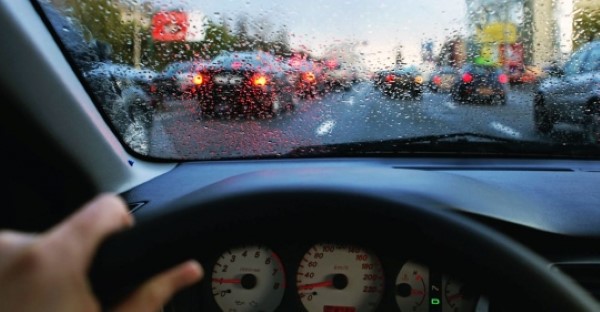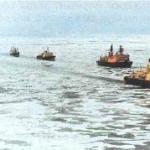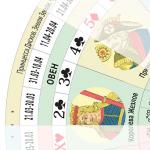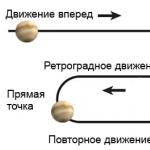Mechanical braking rules. How to brake at a traffic light on the mechanics? Tips from driving instructors
When the vehicle is in motion, it is always must be in gear, and the driver must select the necessary gear according to the speed of the car, since it is believed that in order to quickly perform any maneuver, it is better to be in gear. Only at a complete stop, when the speed of the car is 5-10 km, the driver depress the clutch along with the brake and stops the car.
IN real life few people use this option of braking on the mechanics, since it requires frequent downshifting, which is very tiring and adversely affects fuel consumption, and technical condition gearboxes, which refers to
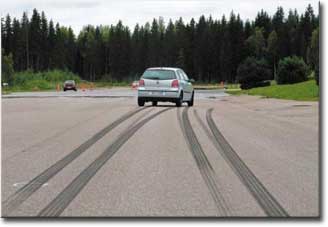
How to quickly stop a car on a hard dry surface (asphalt)
If you need to quickly stop by car, then for this you need press the brake at the same time as the clutch. If you brake in gear, then your braking distance will be slightly, but longer, because in addition to stopping the car, you need to stop the engine. When the wheels are locked, the car stops faster, as it is on the verge of maximum adhesion of the wheels to the road, but when this car is completely out of control, since the wheels stopped spinning, and if the wheels do not spin, then the car does not respond to the steering wheel. The coefficient of adhesion of wheels to the road depends on many factors, read in more detail -. A car with ABS - an anti-lock braking system, is a universal tool, as it provides the fastest stopping of a car without losing control of it. The driver can press the pedal all the way to the "floor" without fear of blocking the wheels. ABS - is an excellent electronic assistant when driving a car, as it does not require focus on blocking the wheels.
Vehicle movement in gear and fuel economy
When the vehicle is in gear, car uses more gas, as it requires keeping your foot on the gas pedal and the higher the engine speed, the greater the fuel consumption. If you stop pressing on the gas, the car will stop from engine braking and the lower the gear, the faster the car will stop. If you are driving down a slight incline, then the gear lever, to save fuel, better put in neutral, so there will be no motor braking effect. Of course, the speed of the car will drop, but not as fast as when driving in gear. Only the forces of air and the friction of the wheels on the asphalt will act on the car. Using this method, you can significantly save fuel. On average, a car with an engine capacity of 1.4 - 1.6 can drive on 1 liter of gasoline in urban areas without "traffic jams", according to passport data, about 12 - 15 km. But there are craftsmen who, using this method of movement and many other methods, can pass about 20 km per 1 liter.
In addition, there are cases when it is strictly forbidden to drive a car in neutral gear. These include movement along mountain serpentines or from the mountain, since without engine braking in low gear, the brakes will overheat and braking distance increases by an average of 25%, and with severe overheating, they can practically not stop the car. Also, moving in gear from a hill reduces fuel consumption, since the engine is spinning “not with gasoline”, but with “wheels”, thereby reducing the fuel supply.
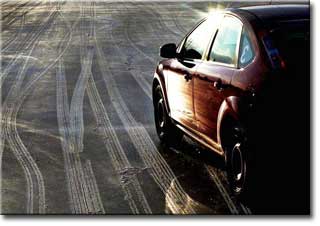
How to brake properly on ice
As many people know, the grip of the wheels of a car on ice is weak, and in order to brake on it as productively as possible, certain methods and techniques must be applied. It is in our time most modern cars have ABS - anti-lock braking system, which prevents the wheels from completely blocking and losing control of the car. Cars of the 90s, 80s do not have such a control device, and all control of the car is entrusted to the driver. Therefore, there are several methods on how to properly brake on ice.
The most important rule for braking on ice is always be in gear and downshift according to car speed. When the car is in gear, it stops thanks to the engine - this concept is called engine braking. The car even stops and slowly, but surely, without blocking the wheels. Thus, it is possible to slow down with the brake pedal, which will be more effective when stopping, and this method will not allow the wheels to completely block, since traction is always maintained on the drive wheels.
one more effective way braking on ice is considered intermittent pressure on the brake pedal. This method mimics the operation of ABS, and will not let the wheels go skidding- complete loss of adhesion of the wheels of a coated car, in other words, block the wheels.
How to properly brake on ice
Each gear of the car's gearbox corresponds to the optimum speed. For a city car, this ratio is as follows, it is taken into account average power mode of the engine for slippery surfaces.
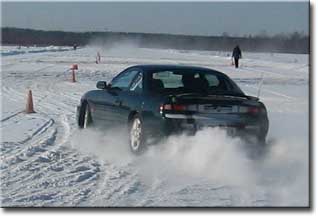
1 gear - 5-10 km / h;
2nd gear - 10-20 km / h;
3rd gear - 20-40 km / h;
4th gear - 40-60 km / h;
5th gear - 60-80 km / h;
It is recommended to turn on low gears according to the speed of the car, because if you turn on a very low gear, for example, turn on 2nd gear at a car speed of 60 km / h, then the engine speed will be over 4,000, and this is the power mode of the motor, and if the wheels have poor grip on the road, they can begin to scroll which can cause the car to skid.
How to brake in front of a traffic light on a slippery surface
To brake in front of a traffic light or in front of the place where you need to stop to a complete stop, you need to stop the car in advance, since it is necessary to take into account many reasons that can increase stopping distance. This is especially true for those factors that impair the grip of the wheels of the car with the road.
Especially at the beginning of winter, when the temperature is plus and can suddenly drop to minus. The driver must be careful and remember this, because in such temperature changes in front of a traffic light rolling is formed - a thin slippery film, which is created from the friction of the wheels of a car and cold asphalt.
Proper engine braking on the mechanics is an effective way to brake on ice. Also, braking correctly on ice in front of a traffic light contributes to safe movement on the road.
Interesting news from the Internet
First car, first car experience, first accident. As practice shows, many unpleasant situations could be avoided by applying this or that technique and knowledge.
Often, young and inexperienced people do not have enough ability to drive during icy conditions or slow down with an engine.
It's okay, everyone goes through it. In order to provide methodological assistance, in this article we will consider the topic: how to properly brake on a car with a manual transmission.
Despite the fact that the automatic type is gaining rapid popularity, many operate the mechanics the old fashioned way.
What you should know
Gearbox braking requires special experience and knowledge. Just sat down and went, it will not work. What are these skills for? First of all, in order to be able to suddenly make or complete a maneuver, to take the car away from the collision.
In other words, without turning off the speed, make a complete stop. Wise man's advice: forever forget coasting in neutral. This is extremely dangerous for both the driver and oncoming traffic.
If there is ice or heavy rain outside, and the driver needs to stop the equipment, then do the following:
- gradually release the accelerator;
- slowly press the brake pedal;
- before the moment of the final stop, we squeeze the clutch so that the car does not stall;
- we bring the rocker to the "neutral" position;
- release all pedals;
- if necessary, we fix the parking lot with a hand brake.
How to brake correctly in a car with a manual transmission
Without touching the clutch pedal, we gently press the brake while simultaneously releasing the gas. Don't worry, the motor will not stall as long as the driving speed is above 3 km/h. Having reduced the speed to the desired one, continue driving, you can switch to a lower gear.
The main rule for the position of the legs, which many beginners confuse: the left is always responsible for the clutch, the right for the accelerator and brake. Only in this way, and not otherwise.
From the first minutes behind the wheel, train yourself not to look under your feet or at the pedals. After a few weeks, all switching actions will occur automatically.
Emergency braking during ice
There was a need for a sudden stop, then do this:
- take your foot off the accelerator;
- squeeze the clutch;
- downshift;
- release the clutch;
- adjust gas.
The main rule is not to give high speed with a slippery surface on the road, otherwise it will skid or throw to the side. The described method is much more effective than stopping with brake pads.
Tight turn ahead
You see a dangerous area approaching, drive like this:
- do not touch the brake pedal at all, this will only aggravate the situation, controllability will be lost;
- clutch has similar requirements;
- do not abruptly release the accelerator;
- for rear-wheel drive type - gradually reduce speed;
- for front-wheel drive - increase speed. Due to the force of gravity, the car will perfectly fit into any turn;
- the steering wheel must be pointed in the direction of the skid. For example, the back of the car slides to the left, which means the steering wheel also to the left, but gradually, without sudden movements. The main thing is to feel the steering wheel.
What threatens the inclusion of "neutral"
Turning off the speed leads to a complete loss of control, the equipment becomes beyond the control of the driver. In most cases, a skid awaits. The inclusion of fourth gear at a speed of 55 - 60 km / h will not help, since the traction torque will not be enough for control at all.
The tachometer will show 2 thousand rpm. To resume control, you need to switch to third gear, accelerate the tachometer to 3500 rpm and add speed to 70 - 75 km / h.
Slippery slopes are a real pain for many drivers, therefore, some sections are allowed to be overcome in reverse. Especially when it comes to front-wheel drive vehicles.
When overcoming descents, use special tires with spikes, mounted chains. Use gradual braking technology, not sudden braking. Then the car will gain stability and controllability will increase. 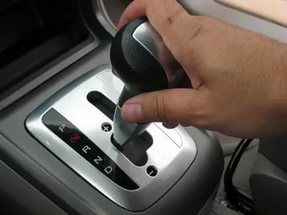
Modern cars boast an additional option in the form of the ABS system - anti-lock. It does not allow the wheels to go to the sides during braking, thus, the likelihood of skidding or skidding is several times reduced.
The essence of the technology: the brake cylinder, having received a command from the control unit of the machine, starts intermittently slowing down until it stops completely vehicle. It is recommended to use this technology on those vehicles that do not have such an option.
When approaching a traffic light:
- in dry road conditions, take your foot off the accelerator pedal;
- gradually apply the brake;
- depress the clutch before coming to a complete stop;
- engage neutral and release the clutch;
- keep your right foot on the brake, as the car can spontaneously roll and create an emergency.
Transfer and fuel consumption
Driving up or down in a gear will increase fuel consumption. Along with this, the level of your security is significantly increased. With skillful use of the pedals, you can overcome 10 - 14 km. per liter of fuel.
Numerous facts of overcoming 21 km are known. one liter of petrol.
What is racing braking
Experienced racers and Formula 1 drivers use the same proven technique when entering dangerous corners - gear braking. First, the speed is reduced to 5000, after which the gear is turned on an order of magnitude lower and a section of the route is overcome at high speed.
It is necessary to reduce the speed to 5 thousand so that when switching to a lower gear, the tachometer needle does not go off scale.
Mode range
- first: up to 20 km / h;
- second: up to 40 km / h;
- third: up to 60 km / h;
- fourth: up to 80 km / h;
- fifth: from 80 and above.
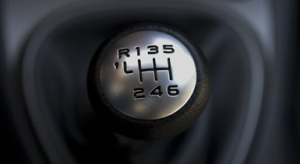
The given example is for informational purposes, each technical means may have its own. For more details on the gear ratios, please refer to the operating instructions for the vehicle.
As for the automatic transmission, everything is tritely simple there. By the way, the clutch pedal in this type of car is missing due to uselessness. Movement and stop are carried out by increasing or decreasing speed.
For full braking use the brake pedal. However, that's a completely different story. Best wishes. Learn to the basics of driving right from the start.
Now you know how to properly brake if your car has a manual transmission, if we missed something, then write about it in the comments. See you soon.
A motorist needs a lot of skills and knowledge to drive well. The most important of these is braking. To stop correctly and quickly, a good reaction is not enough. Precise technical execution plays an important role here. Be sure to learn how to properly brake on the mechanics. Since someone's life may depend on the timely stop of the vehicle.
Normal braking method
In order to slow down on a car with a manual transmission at the included speed, you need to squeeze the brake and clutch at the same time. Moreover, the clutch should be pressed literally a fraction of a second faster than the brake.
If you need to slow down quite a bit, then the clutch should be squeezed all the way. The brake is only applied until the necessary speed reduction is reached. At a full stop, both the speed and the clutch must be squeezed out to the stop. Then you should turn on the neutral gear, and only after that it will be possible to release the pedals. If this is not done, then the car will immediately stall.
Special attention should be paid to how to brake on the mechanics if the car is coasting in neutral gear. In this situation, it is not necessary to depress the clutch when braking. Only the brake pedal should be operated. And if you want to slow down just a little while in gear, you can also not depress the clutch at all. However, if the car starts to twitch, you still have to squeeze the clutch.
Engine braking
It is also worth learning how to brake the engine. This will come in handy when descending steep mountain serpentines.
The main point of this method is the transition from high to low gear. Even if you just lower the gas pedal without changing the gear, the speed of the car will immediately decrease. This will happen due to the fact that the engine will switch to idle mode. Then it will be possible to switch to a lower gear. It is worth considering that after lowering the clutch pedal, you can not press the gas pedal at all. In this way, the braking effect can be enhanced.
The question of how to brake in a car with a manual transmission often makes us think about the correctness of our actions behind the wheel. It is often not possible to ask experts a question, and braking occurs normally without special knowledge. But remember that improper braking on wet or slippery roads can cause serious trouble.
Therefore, it is better to learn how to properly brake on the mechanics using the capabilities of the engine. By the way, this is one of the serious advantages of a manual transmission. The machine will have to rely only on the brake pedal and other active safety features.
We brake with the engine - an express course for winter driving
When roads are covered with snow, there is a risk of skidding when lightly pressing the brake pedal. Experienced drivers try to forget about the existence of this pedal and use it as little as possible while driving. Of course, it is impossible to completely refuse braking with the help of a system designed for this, because the engine can only slow down the car, but not completely stop the car.
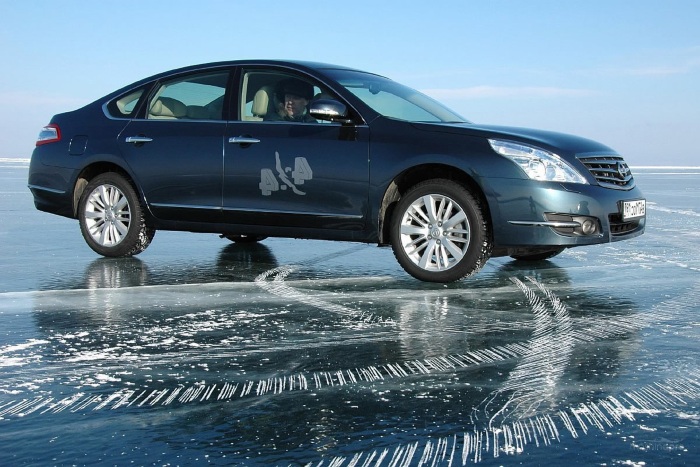
So, engine braking occurs as follows:
- determine in advance the moment when it is necessary to start decelerating;
- depress the clutch and downshift;
- then slowly release the clutch pedal and slow down;
- when the car slows down and takes a free ride, you need to downshift again.
A common mistake many drivers make in this process is engaging first gear at high speed. This leads to several unfortunate consequences. Firstly, it becomes uncomfortable to drive in a car, the driver and passengers nod off every time they try to slow down. Secondly, such braking harms the gearbox by transferring too much torque from the wheels to the gearbox.
It is best to gradually downshift, but do it quickly. If you need to brake urgently, turn on the second gear and immediately after deceleration use the first one. After the final deceleration in first gear, apply the brake pedal to a complete stop.
Other rules for braking on a car with a manual transmission
There are several other features of braking on vehicles with a manual transmission. For example, even in a driving school, most drivers learn that a manual gearbox allows you to slow down the car and make it controllable if you do not turn off the gear. That is, don't shift into neutral every time you're about to stop.
This provides several important benefits:
- full control of the movement of the car and its deceleration;
- more elastic operation of the engine without sudden changes in loads;
- no unnecessary movements to turn on / off gears.
It is important not to overexpose the included gear for more than the recommended minimum. If you were driving in fourth gear, but slowed down to 20 kilometers per hour, it is better to shift into neutral and continue to decide on the desired mode of travel. Otherwise, the engine will not withstand the load, the car will start to twitch, and the engine will simply stall. Such mistakes are often made by novice drivers, which leads to unpleasant situations on the road.
Riding and braking on mountain roads
Everyone knows that on cars with automatic boxes gear manufacturers put much more durable and thicker brake pads. The fact is that when driving on a slope, a car equipped with a manual gearbox has a significant advantage over an automatic one.
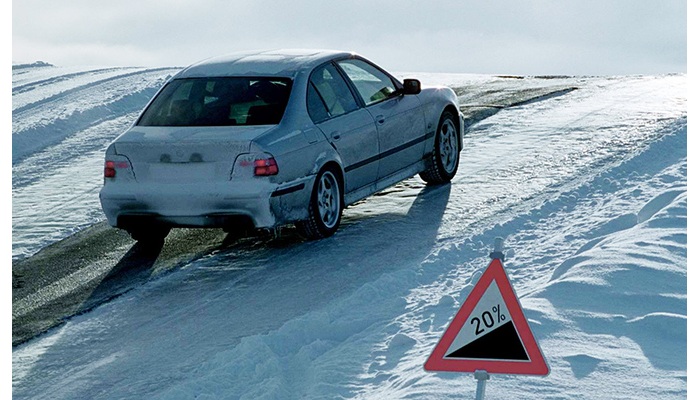
You can control the speed and deceleration of the car with the gearbox, allowing the brakes to rest. The technique of driving a car with mechanics on mountain roads is as follows:
- it is strictly forbidden to turn off the gear and switch to neutral;
- when leaving the mountain we are guided general rules driving - increased speed to unload the engine;
- when driving downhill, use a lower gear and brake exclusively with the engine (as described above);
- you can slow down with the pedal only in cases where you need to turn, and the speed of the car is too high for this.
Such a driving technique will allow you to avoid getting into the deceleration lane in a mountain serpentine. If, nevertheless, the brake pads are worn out, and the car rolls uncontrollably down the mountain, you should calmly use the gearbox and slow down the car during the descent. No handbrakes or other methods of braking can be used here - this is unsafe.
Video:
Summing up
Car owners with mechanical boxes gears have certain advantages in driving a car in mountainous areas, as well as in the operation of brake pads. However, you need to master the engine braking technique and get more benefits from driving a car with a manual transmission.
Remember that every skill you gain in driving a car allows you to become a step higher and get more safety in the operation of the vehicle. Do you know of other ways to brake your car that are as safe as engine braking?
For many drivers, braking seems to be a simple and understandable action: indeed, press the pedal and the car will stop, especially considering modern systems ABS type. But if everything is so elementary and clear, why do accidents happen every day when one car “catches up” with another, or when the car ends up in a ditch or in the oncoming lane?
In fact, far from all drivers know how to calculate the distance and control the necessary force of pressing the pedal. How to slow down in a car so as not to become a participant in an accident?
Braking Basics
There are several simple tips, following which you can minimize the risk of an accident due to improper deceleration on the car.How to brake on the mechanics? Drivers of the old school recommend switching to neutral when approaching a traffic light, which is fundamentally wrong. Such advice is dictated by the desire to save gasoline, but in fact the benefit is very doubtful. If you see a traffic jam or a prohibited traffic light ahead, you do not need to remove your foot from the clutch pedal. Some switch to a lower gear, but on modern cars equipped with powerful engines, there is no need to do this: there will be little sense, but the synchronizers will feel an increased load, which is fraught with their early wear. Such a technique is effective only during a long descent (for example, on a highway). 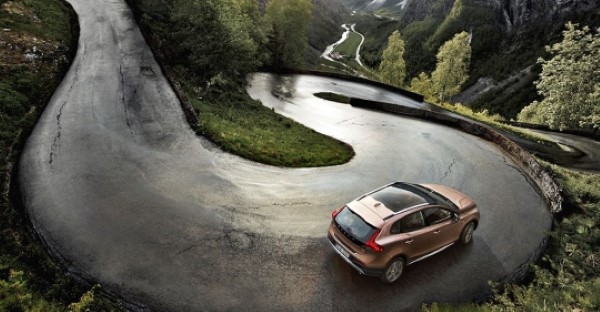
Not all motorists know how to brake with an engine, but this skill is useful, because, thanks to it, you can save a little fuel, extend the life of the pads and discs. Considering that everyone who actively uses a car stops more than a dozen times a day, learning how to brake the engine would be very useful.
The braking process is as follows: by means of a smooth effort on the pedal, the speed is “quenched”, and by the time it comes to a complete stop, the brake is released, and the car reaches the stop point at a low speed, almost close to zero. Learning how to brake properly is not easy: most drivers slam on the brakes at the last moment, causing the car to “nod” its nose.
Why even know how to brake properly?
- For the convenience of passengers. A person who is constantly driving stops noticing the twitching of the car, but his fellow travelers feel the sharp jolts of the car.
- Time to correct the mistake. For example, following a dry road in winter, shortly before a traffic light, you find yourself in a frozen puddle. If you slow down with the usual sharp pressing of the pedal, the car may not stop where it is required, which explains the large number of “engines” near traffic lights in the winter season. It's good if the driver just "catch up" in front parked car, and if he fails to slow down in front of people crossing the road along the "zebra"?
- The ability to control the situation not only in front of the car, but also behind it. By learning to slow down smoothly, the driver reduces the likelihood that the car behind, not expecting a sharp slowdown, will “catch up” with his car.
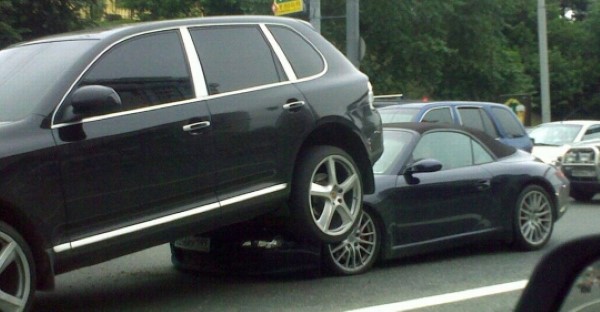
What do you need to know about stopping distance and distance?
In theory, it is clear that it is necessary to keep a distance so that when an obstacle appears, you can slow down and not crash. But how in practice to determine how much time is required for a complete stop, and how many meters the car will travel after pressing the brake? The simplest thing we can recommend is to try to brake hard and take measurements of time and distance. Moreover, it is better to conduct the experiment several times in different conditions: on dry and wet roads, during snow and rain, etc. So the driver will be able to understand exactly how his car will behave under heavy braking. By the way, the test results may be unexpected for the one who drives the car.In addition to practice, there are theoretical studies, according to which the braking distance at a speed of about 80 km / h will not exceed 36 meters. In addition, from school course Physicists know that a doubling of speed results in a fourfold increase in braking distance. 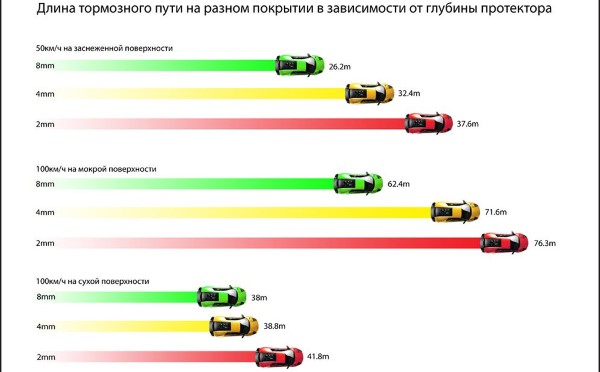
Every car in Russia must regularly undergo a technical inspection: if this requirement of the law is observed, then the actual braking distance will not exceed the above figure. However, there is a large number of people who undergo this examination dishonestly, i.e. for money. Yes, even if you understand that the length of the path will be 36 meters, how much knowledge of this value will give? That is why in practice it is better to measure the braking distance in seconds.
What determines the total time spent on braking?